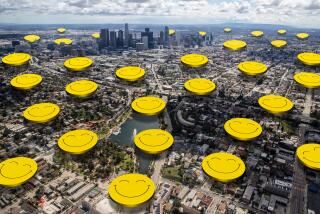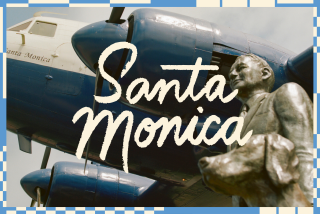Pretty as a Picture : When L.A. Poses in Sparkling Sun, Photographers Scramble
Like avid bird watchers on guard for a rare grackle, postcard photographers lie in wait for a glimpse of a clear Los Angeles sky.
“You become a part-time meteorologist, looking for cold fronts,” said Don Ceppi, who has been shooting Southern California for 12 years. “You phone airports for weather reports and you even have friends check outside where they live.”
And what do you get?
“Five, maybe six really clear days a year,” Ceppi said.
Summer is the peak season for the postcard industry, when sales are swelled by vacationing deltiologists (postcard collectors) as well as just plain tourists.
Many of the sun-kissed shots--like the Santa Monica beach scene sparkling in a store rack--are actually snapped in the winter or spring.
The problem with that time of the year is that something else may be missing besides the smog. “It may be so cold that the beach is deserted,” Ceppi said.
So the ideal would be a summer onslaught of Santa Ana winds that sweep the sky clean. Maybe.
“Then you have to go up in the helicopter and, believe me, Santa Anas are good for aerial photos but not always for aeronautics,” Ceppi said. “You can get blown around pretty good up there. Of course, that’s assuming you can even find one (a helicopter). Every other photographer in town’s probably trying to go up too.”
What the postcard portraitists really long for is a summer rain--if they can take advantage of it.
Ceppi remembers the time he had an assignment in Disneyland on the day after a storm. “I looked up and there was this deep blue sky and these beautiful white, puffy clouds,” he said. “I kept saying to myself, ‘I don’t want to be here. I don’t want to be here. I want to be in a helicopter.’ ”
In case of a sudden clean-air alert, Dick Hart, president of Van Nuys-based National Helicopter, carries a beeper seven days a week, “even when I go to the beach on the weekend. There are so few clear days that I have to be ready to respond if they (photographers) want to hire us.”
Not that customers are likely to sympathize with the ups and downs of skyline shutterbugs.
“I have the impression that most people think that postcards grow in the back of drugstores, if they ever think about where they come from,” said Ceppi, who estimates that he has perhaps 7,500 photos on cards.
After a decline of several years, the picture postcard is undergoing a renaissance. More than 2 billion wish-you-were-heres will crisscross the nation this year, according to the U.S. Postal Service.
Ceppi, 40, a Malibu resident, is one of just a dozen or so photographers shooting full time in the industry in Southern California.
His work is in such demand that he is under contract to a printing company, although most of his colleagues labor on a free-lance basis, selling their photos for one-time-only fees of $25 to $200.
“It’s very hard to make a living that way,” said photographer Craig Aurness. “You have to shoot for something else as well--magazines, advertising agencies, corporate publications.”
Modest though postcard fees may be, competition has sharpened because of the increasing number of hobbyists and young professionals in this, the age of the camera.
Photographers Underfoot
“You ought to see Griffith Park on a clear day,” Aurness said. “You stumble over one photographer after another.”
“Someone may snap a beautiful picture of a sunset, take it to a distributor and be content to have nothing more than a (photo) credit (on the card),” Ceppi said.
What’s more, the traditional favorites--Mann’s (formerly Graumann’s) Chinese Theater, the Capitol Records building, the Hollywood sign--can only be shot so many ways.
“You always try for a different perspective,” Ceppi said. “But on some of these shots, you can almost see the marks in the dirt made by the tripods of others before you.”
Hence the search for a unique vantage point.
Subjects Sometimes Change
“We found a vacant lot in Baldwin Hills where you can get a great picture of downtown L.A. with the snowcaps in the background,” said Bill Ross, co-owner (with Aurness) of a photo distribution company. “You can get it (a clear shot) maybe once every two years.”
Fortunately for local photographers, some stock subjects change through the years, requiring updated shots. A new glass tower sprouts in the Civic Center, revising the skyline, or storms re-sculpt the coastline. Four years ago, Mother Nature cropped the Santa Monica Pier to about two-thirds of its previous length.
Aurness, however, finds the abridged version of the pier aesthetically lacking. “It’s not the graphic, horizontal statement that it once was,” he said. “It’s not as noble.”
Old Picture Trimmed
One small postcard distributor--there are about 500 nationwide--didn’t even bother to reshoot the pier.
“They just trimmed an old photo right where the storm had knocked off the end,” Ceppi said, laughing. “You see some bad fakes in this business--fabricating a new sky, that kind of thing. Sometimes you can see where they couldn’t quite fit in all the clouds.”
Southern California’s haze isn’t always an enemy. A smoggy sky at night can be a photographer’s (if not a breather’s) delight.
Camped on a hill in East Los Angeles, Ross took an evening shot of the Civic Center, crowned by a pink glow on the horizon. It became the cover of a photo book about Southern California. “. . . A Santa Ana wind condition had blown the smog out over Catalina,” giving the sunset its glorious hue, Ross said.
So much for nights. But where does a postcard photographer take aim on summer days?
“Well, you can always shoot a sidewalk, like at Mann’s Chinese Theater,” Ceppi said.
“Or you can go to Utah.”
More to Read
Sign up for The Wild
We’ll help you find the best places to hike, bike and run, as well as the perfect silent spots for meditation and yoga.
You may occasionally receive promotional content from the Los Angeles Times.






